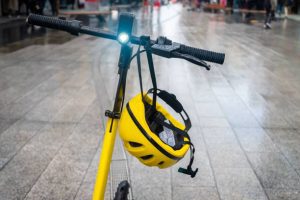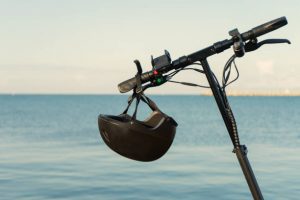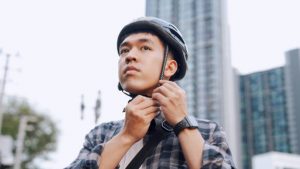Looking for some safety tips for short scooter rides? We’re excited you’re here, ready to embark on your scooter-riding journey with FamilyHype!
Short distance riding with a scooter is a convenient and eco-friendly way for people and riders alike to navigate busy urban areas, offering a practical alternative to traditional vehicles like bikes or cars. However, ensuring scooter safety is paramount; wearing a helmet, adhering to safety tips, obeying all traffic laws, and practicing scooter safety tips not only save lives but also promote responsible and secure commuting for all riders and pedestrians
Riding a scooter can be a fun one, but we also want you to be protected. Unlike other vehicles and motorcycles, scooters have their own style and balancing requirements. Of course, children love scooters! Whether you’re one of the seasoned riders or a beginner, safety must always be paramount.
It’s not just about long trips; even quick trips require the right precautions. We’ve compiled this guide to ensure you’re equipped with the right knowledge for fun and safe short trips.
From mechanics to protective gear, traffic rules to defensive riding, visibility, speed, weather considerations, and even parking and locking up your scooter, we’ll explore the ins and outs of your journey.
We hope you’ll find these tips invaluable and that they will help you make every short trip a safe and enjoyable one. Please share your feedback on your experience or opinions about this content with us at FamilyHype!

As part of the transportation industry, we strive to provide a safer environment for ourselves and the community. Other members of the industry include bicycles, cars, skateboards, and trains – all of which have their own unique set of rules, regulations, and safety considerations.
Let’s get started and make every short trip a safe and enjoyable one! Read these riding tips.
Key Takeaways
- Understanding the mechanics and performing regular maintenance is crucial for safe riding.
- Wearing appropriate safety gear, such as helmets, elbow pads, knee pads, and reflective clothing, is essential.
- Following traffic rules, riding defensively, and being aware of surroundings are important for avoiding accidents.
- Maintaining a safe speed, considering weather conditions, and parking securely contribute to scooter safety.
Understand Your Scooter’s Mechanics
Before you hop on for a quick zip around the block, it’s important you’ve got a handle on how your scooter works, from the throttle to the brakes. Maintenance isn’t just about keeping your trip in tip-top shape, it’s also about understanding the intricacies of its mechanics.
You also need to check each wheel. When you ride, avoid potholes, and wear gloves and helmets. Don’t crash with other vehicles and avoid any danger. This knowledge equips you to ride safely.
Understanding brakes is crucial. Know how much pressure to apply for a gradual stop or an emergency halt. Recognize the feel of a brake that’s too loose or too tight. Stay safe with other riders. This awareness can be the difference between a smooth trip and a potential mishap.
Now that we’ve grasped the basics, let’s not overlook the importance of a pre-ride inspection. It’s time to delve into the vital routine of checking your scooter before each trip.

Inspect Your Scooter Before Each Ride
Always remember, a quick once-over of your trusty two-wheeler can mean the difference between a smooth journey and an unexpected mishap.
It’s essential to inspect your scooter before each trip, and it doesn’t have to be a lengthy process. Start with a tire condition check; ensure they’re properly inflated and free of any cuts or bulges that could lead to a puncture.
Next, perform a brake check. Squeeze the brake levers and make sure they respond promptly. A slow response or any unusual sounds could indicate a problem that needs immediate attention.
These simple checks help ensure a safe trip, keeping you and others around you protected.
In continuing our journey towards a safer trip, we’ll next explore the critical importance of sporting appropriate protective gear.
Wear Appropriate Safety Gear
Now, let’s talk about the appropriate protective gear you must always wear.
Helmets are non-negotiable as they provide crucial protection for your head in case of a fall.
Elbow and knee pads can prevent painful scrapes and bruises, and wearing reflective clothing, especially if you’re riding in low-light conditions, can significantly improve your visibility to others on the road.

Helmets For Safe Short Rides
Don’t forget strapping on a helmet is a must, even for those quick scoots around the block. We can’t overstate the vital role helmets play in protecting us from potential head injuries. It’s not just about wearing any helmet, but one that fits perfectly.
When it comes to helmet sizes, ensure it snugly fits your head. It must neither be too tight nor too loose. A well-fitted helmet provides optimal protection and comfort. Alongside size, helmet maintenance is equally essential. Regularly inspect it for any signs of wear and tear, and replace it promptly if needed.
Remember, a helmet is your first line of defense. With this in mind, let’s not forget the other protective gear like elbow and knee pads. They, too, contribute significantly to our protection during our short trips.
Elbow And Knee Pads For Safe Short Rides
Slipping on your elbow and knee pads might seem like a bit of a hassle, but imagine them as your trusty sidekicks, ready to take a hit for you when you’re cruising around the neighborhood. These protective gears are vital in ensuring your safety during those quick trips.
There are a few things to consider when choosing the perfect pair:
- Pad Durability: Opt for high-quality pads that can withstand high impact, ensuring optimal protection.
- The Importance of a Good Fit: Use a sizing guide to ensure your pads fit snugly and comfortably without restricting movement.
- Your Comfort Matters: Pads must be breathable and lightweight, allowing for ease during your trips.
Next, we’ll discuss the importance of reflective clothing for visibility, another key component of safety.

Reflective Clothing For Visibility For Safe Short Rides
Imagine cruising through the city streets as twilight descends, your silhouette illuminated by the gleam of your reflective clothing, making you a beacon of light in the encroaching darkness. We can’t overstate the importance of high-visibility materials in safety, especially for those short but vital trips.
Wearing reflective clothing increases your nighttime visibility, helping other drivers spot you more easily. This not only ensures your safety but also contributes to the welfare of others by reducing potential accidents. It’s a simple step that can make a world of difference.
Remember, safety isn’t just about physical protection; it’s also about being seen.
As we move towards the next section, let’s discuss how to navigate the streets safely by adhering to traffic rules.
Follow Traffic Rules And Regulations
Abiding by traffic rules isn’t just important for your protection, it’s also crucial for maintaining harmony on the road and preventing accidents that could involve other road users. When we’re on our scooters for short trips, it’s easy to get caught up in the thrill of the trip and forget about basic pedestrian etiquette and signal usage.
To ensure everyone’s protection, let’s remember to:
- Follow pedestrian etiquette:
- Give way to pedestrians on the sidewalk
- Don’t ride recklessly or too fast
- Use signals properly:
- Let others know your intentions before turning
- Signal when stopping
By adhering to these rules, we make the road safer for everyone.
Now that we’ve covered traffic rules let’s transition smoothly into the importance of practicing defensive riding.
Practice Defensive Riding All The Time
As we’ve just discussed, observing traffic rules is a key factor in ensuring our trips are safe and enjoyable. Now, let’s shift gears and focus on another vital aspect: practicing defensive riding.
As we zip through our neighborhoods, it’s crucial to always anticipate hazards. This involves constantly scanning our environment for potential dangers, like errant pedestrians or sudden obstructions. By doing so, we can react swiftly and execute emergency maneuvers, avoiding any potential mishaps.
It’s equally important to remember that we’re not alone on the roads; we need to respect other road users too. In the next section, we’ll delve deeper into this concept of maintaining an acute awareness of our surroundings, which is an integral part of our defensive riding strategy.
Be Aware of Your Surroundings
Let’s face it, you can’t predict every move in a bustling city, but being hyper-aware of your surroundings certainly tips the scales in your favor.
It’s not just about looking straight ahead but also understanding the peripheral vision importance. This wider field of view can alert you to potential hazards that might sneak up on you, like a car turning unexpectedly or a pedestrian stepping off a curb.
Distraction avoidance techniques are also key. Resist the urge to check your phone, adjust your music, or get lost in thought. Stay present and focused on the environment around you. Through these actions, you’ll be more equipped to respond rapidly and safely to any unexpected events.
Now, let’s shed some light on how to ensure proper visibility during your rides.
Ensure Proper Visibility
Navigating the city streets, you’ve got to make sure you’re visible to others at all times, particularly during twilight hours or in less-than-ideal weather conditions. Visibility techniques are key to ensuring you’re not only seen but safe.
Consider investing in lighting accessories, such as reflective decals or LED lights. These accessories increase your visibility, making it easier for motorists and pedestrians to spot you.
Don’t underestimate the importance of wearing bright, reflective clothing either. This is another effective method to enhance visibility, especially during the dim light of dawn or dusk.
Remember, our goal is to create a safe environment for everyone on the road. Now that we’ve covered visibility, let’s shift gears and talk about the importance of maintaining a good speed.
Maintain A Safe Speed
Zipping around town at breakneck speed might seem exhilarating, but it’s important to remember that maintaining a reasonable pace is vital for your well-being and those around you. The speed regulation isn’t just about rules; it’s also about fostering a safer environment for everyone.
This is the main reason why you must maintain a safe speed. A scooter is not like a bicycle, where you can sit and have more control over your body. Since you’re standing, there’s a chance that you will lose balance easily.
It allows for better control and response in unexpected situations. It reduces the risk of accidents and injuries. It shows respect for other road users.
Always ensure velocity control when riding because the impact of your actions resonates beyond you, affecting the safety and comfort of everyone around. Remember, we’re all in this together.
As we strive to make every trip safe and fun, we must also consider the weather conditions. Let’s learn how to navigate the unpredictable weather to maintain our protection.
Avoid Riding In Bad Weather
When dark clouds loom overhead, and the scent of rain hangs in the air, it’s best to reconsider your plans of hitting the road. We know the thrill of a quick trip, but safety must always come first.
Weather predictions are a crucial part of planning any trip. A sudden downpour can make the roads slippery, reducing traction and increasing the chances of an accident. Rainy trip aren’t just uncomfortable; they’re a risk we must not take lightly.
We can’t stress enough the importance of checking the forecast before heading out. Let’s be smart about our safety and that of others around us.
Now that we’ve talked about the perils of riding in bad weather let’s move on to the important discussion about securing and parking your scooter safely.
Safe Parking And Locking Up Your Scooter
Transitioning from weather considerations, let’s shift our focus to another aspect of protection: parking and locking your scooter securely.
As much as we enjoy the thrill of a quick scooter trip, it’s vital to remember that our fun trips require responsible actions, ensuring our scooters’ safety. Scooter insurance is a wise investment, offering protection against theft or damage. It’s one way we can serve ourselves and our community by alleviating potential burdens.
Alongside insurance, using anti-theft devices further secures our scooters. Robust locks and alarms deter opportunistic thieves, allowing us to park with peace of mind.
Remember, the fun of a quick ride must not end in worry about its safety. So, let’s park smartly, lock securely, and ride confidently.
Conclusion
We’ve covered a lot of ground, haven’t we? From understanding our scooter’s mechanics to practicing defensive riding, we’re now equipped to tackle short trips safely.
Remember, safety gear is a must, and obeying traffic rules is non-negotiable. Let’s always ensure we’re visible, maintain safe speeds, avoid bad weather, and securely park and lock up our scooters.
There are endless opportunities for exploration, convenience, and efficiency. Here’s to fun, safe trips every time!
Frequently Asked Questions (FAQs)
What age must kids wear helmets?
Kids must wear helmets whenever they engage in activities that involve the risk of head injury, such as cycling, skateboarding, rollerblading, or riding a scooter. It is recommended for kids wear helmets from a young age and make it a habit for all relevant activities.
What is the best age to start on a scooter?
The best age to start can vary depending on the child’s development and coordination. Some children may be ready to start around 3 to 4 years old, while others may start later. It is important to consider a child’s individual abilities and readiness before introducing them to scooters.
What are most common scooter accidents?
The most common accidents include falls due to loss of balance, collisions with obstacles or pedestrians, and accidents caused by unsafe riding practices. Head injuries, sprained wrists, and abrasions are among the most frequently reported injuries resulting from accidents.
Which is the best brand?
Several reputable brands offer high-quality scooters for kids. Some popular and well-regarded brands include Razor, Micro, Fuzion, Envy, and Globber. It’s recommended to research different brands, read customer reviews, and consider factors like quality, performance, and budget when selecting a brand.
What are the injuries to scooters for kids?
Injuries related to scooters for kids can include bruises, scrapes, sprains, fractures, and head injuries. These injuries can occur from falls, collisions, or improper handling. Wearing protective gear and practicing safe riding habits can help prevent such injuries.
Are scooters safe for 7-year-olds?
Scooters can be safe for 7-year-olds when appropriate safety measures are taken. Ensure that the scooter is the right size for the child, they wear protective gear, and they are supervised while riding. Teaching them proper safety rules and riding in safe areas can also enhance their safety.
Should kids wear a helmet?
Yes, kids must wear a helmet when they ride a bike. Helmets protect against head injuries and must be worn consistently regardless of the type of ride. It is essential to ensure that the helmet fits properly and meets safety standards.
How can you be safe on a scooter?
Follow these guidelines: wear a helmet and appropriate protective gear, ride in safe areas away from traffic, obey all traffic rules and signals, be aware of surroundings, ride at a controlled speed, use hand signals for turning, and avoid risky maneuvers or stunts.
At what age can a child wear a helmet?
Children can start wearing helmets as soon as they engage in activities that may pose a risk of head injury. This can begin as early as when they start riding tricycles or using balance bikes. Helmets must fit properly and be comfortable for the child.
How do I choose a scooter for my child?
Consider factors such as age, size, weight capacity of the scooter, stability, durability, and safety features. Ensure that the scooter is appropriate for their skill level and matches their intended use (e.g., recreational or commuting).
DISCLAIMER (IMPORTANT): This information (including all text, images, audio, or other formats on FamilyHype.com) is not intended to be a substitute for informed professional advice, diagnosis, endorsement or treatment. You should not take any action or avoid taking action without consulting a qualified professional. Always seek the advice of your physician or other qualified health provider with any questions about medical conditions. Do not disregard professional medical advice or delay seeking advice or treatment because of something you have read here a FamilyHype.com.